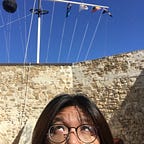Entering or Switching to UXR
Before we talk about entering UXR, do check if UXR is the right thing for you.
Make your past experience as your advantage, not shortage
If you are not from so-called “related” background, likely the hiring manager might not be familiar with the background you came from. It’s your task to onboard them to know more about your background and to explain how your past experience can add value to the role, the team, the project, the company, and the mission.
A small tip is to build the connection between your past experience to the role you planned to apply. For example, a new graduate trained in business might be able to demonstrate the business analysis or projection on top of the UXR case. Someone transferred from a reporter probably can demonstrate writing a few articles about users as an alternative to spread out users’ stories in the organization.
As the applicant coming from an unexpected background, helping the hiring manager imagine how you can potentially add sparks in the team can be a WOW moment if well planned.
New graduates, UXDs and academia researchers are the top three groups reaching out to me in these conversations. Here I’d share my thoughts to each groups:
As a NEW Graduate
Just graduated from education, to be honest, you usually have less bargaining power. However, at an earlier stage of your career, the cost of exploring new areas is much lower now than later. Try to think about how your education background can add value into the role you want to apply and/or how you can utilize your background.
If you’re trying to apply to different roles, e.g. UXR and UXD, do try to adjust your resume and portfolio accordingly. We’ll talk about preparing resumes, portfolio & interviews in another article. Basically different roles require different skills. Especially for applying UX roles, preparing the resume & portfolio can demonstrate the consideration of the readers’ experience.
As a UXD
UXD is usually in charge of building the solutions to solve the problems for the users. However, UXR is not. A UXD’s portfolio is usually full of flows, animations, visual concepts, and design elements, etc. However, these are good to have but not expected for a UXR applicant. Though UXR usually works closely with UXD, the requirements for each role are different.
As a UXD intends to switch to UXR, an advantage you can probably take is that you understand UXD. You understand what information from the research might be helpful to the UXD. You understand how UXR findings can help the UXD design a better solution to serve the users. You can probably present your recommendations from the research visually, which not all the UXR can do. Don’t just mention it in the interview, demonstrating that superpower in the cases of your portfolio.
As an academia researcher
Quite some people thought that researchers are all doing similar work. That’s fundamentally true. All the research is to find out something that we don’t know yet. However, academia research usually prioritizes experimental method related factors, e.g. standardized procedure, controlled condition, consistent treatments, and statistical analysis, etc., which in many cases are very similar to A/B testing. In that case, we care about if the treatment contributed an effect that significantly affects the dependent variable, how the dependent variable is measured, did we randomly apply each treatment to different groups? etc.
In product research, we prioritize the context and user-related factors more. A lot of time we need to compromise the research plan based on limitations like timeline, resources, etc. The purpose of conducting product research is to help the team solve the right problem in the right ways. How to generate the useful insights within all the limitations efficiently, is the challenge the UXR is facing.
So unless you’re at very relevant fields to the role you want to apply to, e.g. AR, VR, AI, etc. otherwise please stop showing a list of your publications or articles cited by other researchers on the first page of your resume/portfolio. Try to help the readers understand what are the questions you tried to answer for each study in a few sentences. What are the top findings that are potentially helpful for application in the future? And what are the potential impacts these findings can make?
Start your own project to demonstrate your capability
Regardless of your background, anyone wanting to switch or enter the UXR field is expected to demonstrate capability of planning a research, conducting a research, analyzing the findings, and sharing the result with the core team. For senior roles, providing actionable suggestions, and advocating for user-centric culture are pluses.
The bad news is that before you join a product officially, you usually don’t have the full picture of the entire product. You wouldn’t know how many users comment on others’ posts, or how many fraud messages are reported or detected everyday. Hence you can’t decide which issue is more critical to be solved.
The good news is, you don’t need permission to start doing research to solve a problem for the users. Try to identify a specific challenge in real life, list the problem statement, plan a research to find out the answer, and put everything together. The challenge can be “What stops the elderly from adopting digital banking service?”, “How can we help people to manage their physical vouchers from different merchants?”, and more challenges that people are facing in modern life.
Learnings form 50+ mentorship practice in 2022
In the year of 2022 I took time talking to people who are interested in topics around Product, Design, Research, Career, Asia, etc. After 50+ conversations, I want to write down what I learned from these conversations.
